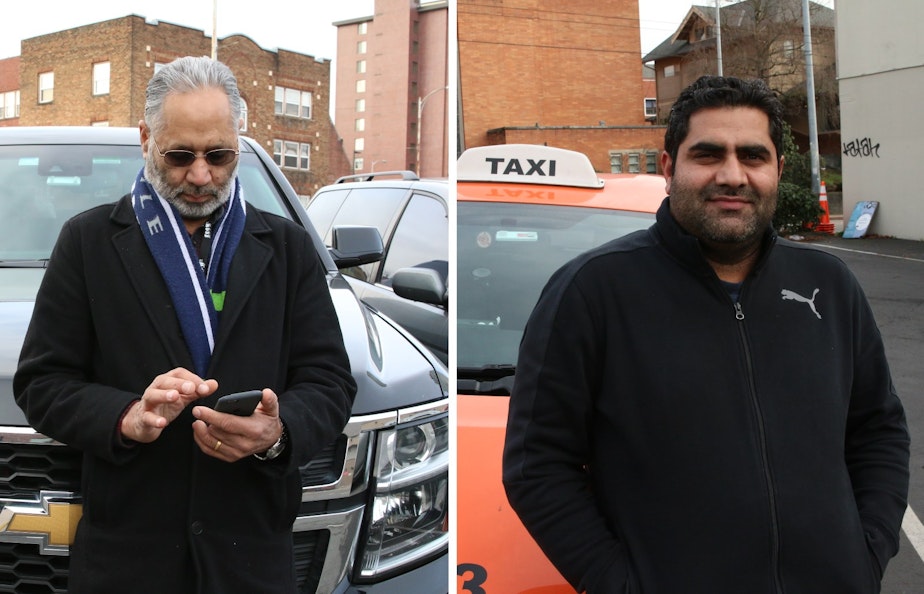Two taxi drivers: One switched to Uber, one didn't. Both of their lives changed.

When Uber came to Seattle almost 10 years ago, it changed how people here hire cars.
The company changed the fortunes and lives of two taxi drivers, whose divergent paths illustrate how Uber fractured the taxi industry.
Sukhchain Banwait and Ramandeep Singh have known each other for years.
“We are good friends. We go together to Starbucks and have a coffee,” Singh said.
And they used to drive cabs together for Seattle Orange Cab.
When Uber came to town in 2011, it started recruiting drivers for its luxury service, Uber Black.
Singh didn’t bite.
Sponsored
“I was happy with my job,” he said.
But Banwait was excited. He was frustrated with how long customers had to wait for a cab — so long, that sometimes, customers would have found another ride by the time he reached them. Moreover, he was tired of the way his customers slammed the door on his Prius, which hurt his ears.
Sponsored
Banwait liked that customers paid through an app, on Uber; he was tired of handling money.
“I hate cash!" he said. "Cash sometimes smells so bad. I stick it in my pocket here, my clothes are smelling, my hair...”
“They’re pulling money from their shoes, you know,” Singh added. "Especially if you're picking up people on Third Avenue."
For awhile, Banwait was happy with the switch.
“Money was good,” he said.
Sponsored
He and his son bought a new SUV and made $80,000 their first year with Uber, minus work expenses. But then, Uber introduced its more affordable Uber X service.
More and more drivers joined the platform, and Banwait's money plummeted.
“Now, if I make $45,000 – $50,000, I’m lucky,” he said.
Sponsored
As disappointing as things were for Banwait, they were worse for Singh in his taxi.
The cost of choosing not to change proved high. Singh's income fell from $46,000 a year to $20,000.
“It makes everyone concerned when it feels like they’re working for nothing," he said.
"Back in the day, you worked easy," he continued. "You get an easy flag, easy call. These days you have to hustle. Back in the day, you didn’t even want to get out of the city. These days, you go for 15 miles for $7. You go to West Seattle, you go to Northgate, you go to Bellevue for $10."
But it’s not just about the money.
Sponsored
Another thing that changed, after Uber disrupted the industry, was what kind of customers they picked up.
Sponsored
Banwait, who chose Uber, thought of himself like a limo driver. He picked people up from the airport and people going to business meetings. He dressed up for it.
“I hate a tie sometimes; this button is too tight on the shirt," he said. "But still, I have to do it.”
Uber indeed made him wear a tie "at the start." But when the lower-priced Uber X service came in, those rules loosened.
“Now, I have seen the people in the sweatshirts. Sweatshirts, sweatpants, you know.”
But Banwait still dresses up. It's a matter of pride.
And while Uber’s service is growing in low income neighborhoods, one study shows that the most frequent users of Uber have household incomes over $200,000.
Sponsored
Taxis survived by going in a different direction. They focused on a kind of work that Uber can’t get: Government contracts.
Their drivers are more heavily vetted and even get fingerprinted. That makes these taxi drivers eligible for those government contracts, through which they take homeless kids to school and take Medicaid patients to hospitals, for example.
There are other kinds of customers too. People who don’t have smart phones, old people, and young people who recently moved from New York.
Then there's people who can’t find their car.
“Especially if they’re drunk at night — late at night,” Singh said.
But those non-government contract rides are far and few between.
“We have ways to survive, but it’s very hard. Very hard," he added.
Sponsored
Today, Singh and Banwait don’t see each other as much as they once did. Uber driver Banwait joined the Teamsters, and he’s fighting for better wages for drivers. Taxi driver Singh said he would quit driving today if he could find better work.
The two friends' stories exemplify show how Uber fractured the taxi industry.
But Caleb Weaver, a spokesperson for Uber, argued that taxis were hobbled by over-regulation, which limited the taxi industry's ability meet pent-up market demand. When Uber brought in new drivers, Weaver said, Uber grew the market in ways taxis were never able to do on their own.
“The number of trips that rideshare is doing in Seattle did not come just at the expense of taxis," he said. "It has grown the overall pie. Which means you have many more drivers out there that are able to make money.”
What’s frustrating for both Singh and Banwait is how their piece of the pie has shrunk to where they say it’s hardly a pie worth eating anymore.
This story is part an ongoing series by KUOW Reporter Joshua McNichols. He is examining the impact of Uber and Lyft as the city of Seattle studies whether drivers are earning a liveable wage.

